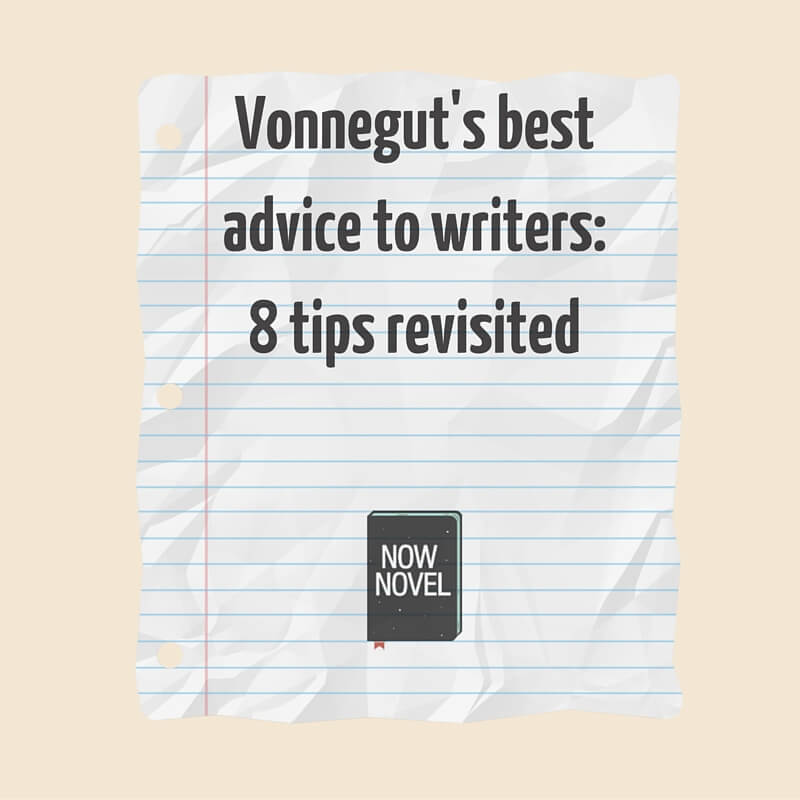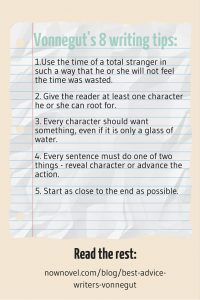The great writer Kurt Vonnegut’s best advice to writers, the 8 ‘rules’ reprinted in his story collection Bagombo Snuff Box (1999), has been shared often. Read Vonnegut’s creative writing tips below. We ask: Are they good rules?
First: Who is Kurt Vonnegut?
If you aren’t familiar with Vonnegut’s writing, Kurt Vonnegut Jr (November 11, 1922 to April 11, 2007) was a prolific American author and (later in his career) lecturer in creative writing at Harvard University. In total, Vonnegut wrote and published fourteen novels, three short story collections, and five non-fiction books during a career that lasted over 50 years. His fame was cemented only after he published his sixth novel, Slaughterhouse-Five, in 1969. The satirical book about the follies of World War II became a New York Times bestseller and thrust Vonnegut into the spotlight.
Re-examining Vonnegut’s best advice to writers, his ‘Creative Writing 101’
In the introduction to the collection of short stories Bagombo Snuff Box, Vonnegut writes:
‘Now lend me your ears. Here is Creative Writing 101:
1. Use the time of a total stranger in such a way that he or she will not feel the time was wasted.
2. Give the reader at least one character he or she can root for.
3. Every character should want something, even if it is only a glass of water.
4. Every sentence must do one of two things — reveal character or advance the action.
5. Start as close to the end as possible.
6. Be a sadist. No matter how sweet and innocent your leading characters, make awful things happen to them — in order that the reader may see what they are made of.
7. Write to please just one person. If you open a window and make love to the world, so to speak, your story will get pneumonia.
8. Give your readers as much information as possible as soon as possible. To heck with suspense. Readers should have such complete understanding of what is going on, where and why, that they could finish the story themselves, should cockroaches eat the last few pages.‘
Let’s look closer at each of these instructions. Are they helpful as guides to writing?
Writing tip 1: Don’t waste a stranger’s (i.e. reader’s) time
This is fairly vague and broad advice. If you describe your character’s face or abode in exquisite detail, one reader might feel you’ve wasted their time while another might be enthralled. There is a core of truth here, though: Choose what to tell the reader wisely. Just as in a conversation you’d try to leave out the boring parts, do the same in your writing.
Some ways to make sure you don’t waste readers’ time:
- Know the purpose of each scene in your story. You should be able to summarise it in a single sentence. This will keep you focused on core story events
- Know your audience: If you’re writing for thriller lovers, for example, keep philosophical, literary ramblings to a minimum
- Join a writing group and get helpful feedback – readers will let you know if you’ve wasted their time, giving you plenty of insight for revision
Writing tip 2: Give the reader at least one character he or she can root for
Vonnegut’s writing advice is sound here. To win over readers, there needs to be connection. If your characters are universally contemptible and unpleasant, you could still write a gripping or interesting book, though. If the style and content of your story is interesting, full of tension and drama and incident, some readers may overlook the fact there isn’t a particularly relateable character in the story. This works for writers of so-called ‘transgressive fiction’ such as Bret Easton Ellis.
Also remember that a character the reader can root for doesn’t have to be perfect. Great characters have flaws for two reasons:
- Flaws make characters more believable (since most people have them)
- Flaws are a source of inner conflict in your story. Inner conflict creates the desire to keep reading, since readers will want to find out whether your character prevails or crumbles.
Writing tip 3: Make every character want something
This is arguably some of Vonnegut’s best advice to writers. Character motivations drive a story.When characters share goals (as the adventuring party does in Lord of the Rings, for instance), you can show how the bonds of friendship form as well as the intimacy, affection and humour between people collaborating around a shared objective.
When characters want opposing things, however, there is opportunity for conflict and magnificent rivalry and tension. This could be the conflict between siblings who want the lion’s share of their parents’ attention or fortune (as in Shakespeare’s King Lear) or it could be the opposition between a tyrant’s desire for world domination and the desire for freedom from tyranny that drives a hero’s journey.
The many possibilities for affect and suspense-building tension contained within character motivation makes it wise to outline each character’s central story goals when you outline your novel.
Writing tip 4: Make every sentence reveal character or advance action
Vonnegut’s fourth piece of writing advice is questionable. Of course steady advance in action makes a story interesting. And character revelation deepens how we understand and relate to story characters. Sometimes there are whole, good paragraphs that do neither, however.
Setting description, for example, can help to establish mood and tone for a scene or chapter. This is often necessary because without these cues, a story might lack a strong sense of contrast and place, becoming drab. The Lord of the Rings would be much less epic in scope and feel if it weren’t for descriptions such as the following of Mordor:
‘The gasping pools were choked with ash and crawling muds, sickly white and grey, as if the mountains had vomitted the filth of their entrails upon the lands about. High mounds of crushed and powdered rock, great cones of earth fire-blasted and poison-stained, stood like an obscene graveyard in endless rows, slowly revealed in the reluctant light.’
In short, every sentence should simply be good. It should contribute character insight, a gripping sense of action or place, mood and affect.
Writing tip 5: Start as close to the end as possible
Many stories start long before the end. Especially multi-volume series. C.S. Lewis’ Narnia series starts with British children discovering the mythical world of Narnia and later portrays them as grown adults living in the same world. So start wherever you like.
If you were writing a murder mystery, for example, you could start from the days leading up to the event or the moment the act is committed. You could start with detectives investigating the scene after the event. You could even start from the moment the killer’s sentence is handed down, though, and work your way backwards to show what led to these circumstances.
What Vonnegut’s writing advice here gets at, though, is that a good story doesn’t have a long-winded preamble. It’s not as important that you start close to the end as it is important that you elicit curiosity from the start.
Writing tip 6: Make awful things happen to your characters so the reader can see what they’re made of
Vonnegut’s writing advice to be sadistic to your characters is useful to a point. Even books for young readers often have dark, subversive elements (the books of Roald Dahl are a good example). This is because seeing characters struggle against adversity we can relate to our own challenges. We can learn from characters’ trials.
We can (and should) learn what characters are made of through the good things too, however. Vonnegut appears to suggest that it is in adversity specifically that we see what people are made of. But success can be revealing too. One person who becomes extremely wealthy, for example, might withdraw and become paranoid and obsessive about guarding their wealth. Another might become philanthropic and generous. It all depends on how you frame what happens to your characters (and how they frame their own experiences). What separates the choices of the example characters above is most likely how they frame their wealth and the stories they tell themselves about it to rationalize their behaviour.
In short, awful things and good things are both interesting and can illustrate character when you show the different ways characters in your story frame the same event.
Writing tip 7: Write to please just one person
Vonnegut makes a good point, that you can’t please every single reader. If you do write to please just one person, you could make that person yourself. When you write the story you’ve always wanted to read (as Toni Morrison advises), there’s a good chance someone out there has always wanted to read that story too.
What Vonnegut’s writing advice here doesn’t touch on is the idea of audience. If you’re writing in a specific genre, there may be a specific type of reader your book will appeal to. But there is also the general audience for that genre. Most readers of thrillers, romances, and other genres will expect certain genre conventions (or be wary of genre clichés that are overused). Know your genre and your audience, and plan ways to surprise them with new twists on classic tropes.
Writing tip 8: Give readers as much information as you can as early as possible
This, again, is dubious advice. There are many ways to tell a story. If your style and your prose and your characters are all interesting, readers might easily forgive a more teasing, elliptical approach. This all depends on your genre too – a mystery novel will naturally leave more for the slow reveal than a straightforward romantic comedy will.
The latter part of Vonnegut’s eighth point is good advice, though. Give readers the information they need to understand where they are in the story, so that they can grasp both the place and purpose of every scene. Outlining your novel and making sure it fits together as a cohesive whole will go a long way towards this.
Vonnegut himself acknowledged that his ‘creative writing 101’ was provisional; that great writers break the rules. Immediately after his 8 rules, he writes:
‘The greatest American short story writer of my generation was Flannery O’Connor (1925-1964). She broke practically every one of my rules but the first. Great writers tend to do that.’
So remember (whenever you read writing rules) to ask questions and decide for yourself how relevant and helpful the rule is for your own writing practice.
Outlining (as a rule) works. It gives you a guiding plan for your story that can be as flexible as you choose. Start creating a helpful blueprint for your story on Now Novel and finish writing a book.




4 replies on “Vonnegut’s best advice to writers: 8 tips revisited”
These are great tips and I believe in them completely. I wish all authors did (at least genre authors).
Which is your favourite? Thanks for weighing in, Lexa.
To me, 2 & 3 are the most important. And I admit I may be a bit too gleeful in doing 6. 😉
3 is important, I agree. A source of glee in writing is a helpful thing to have 🙂